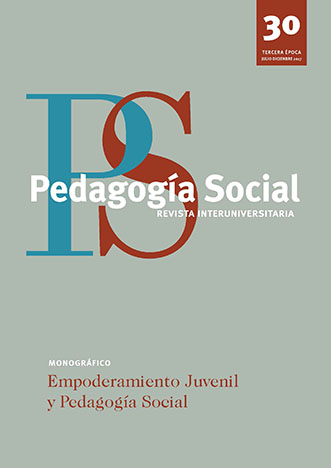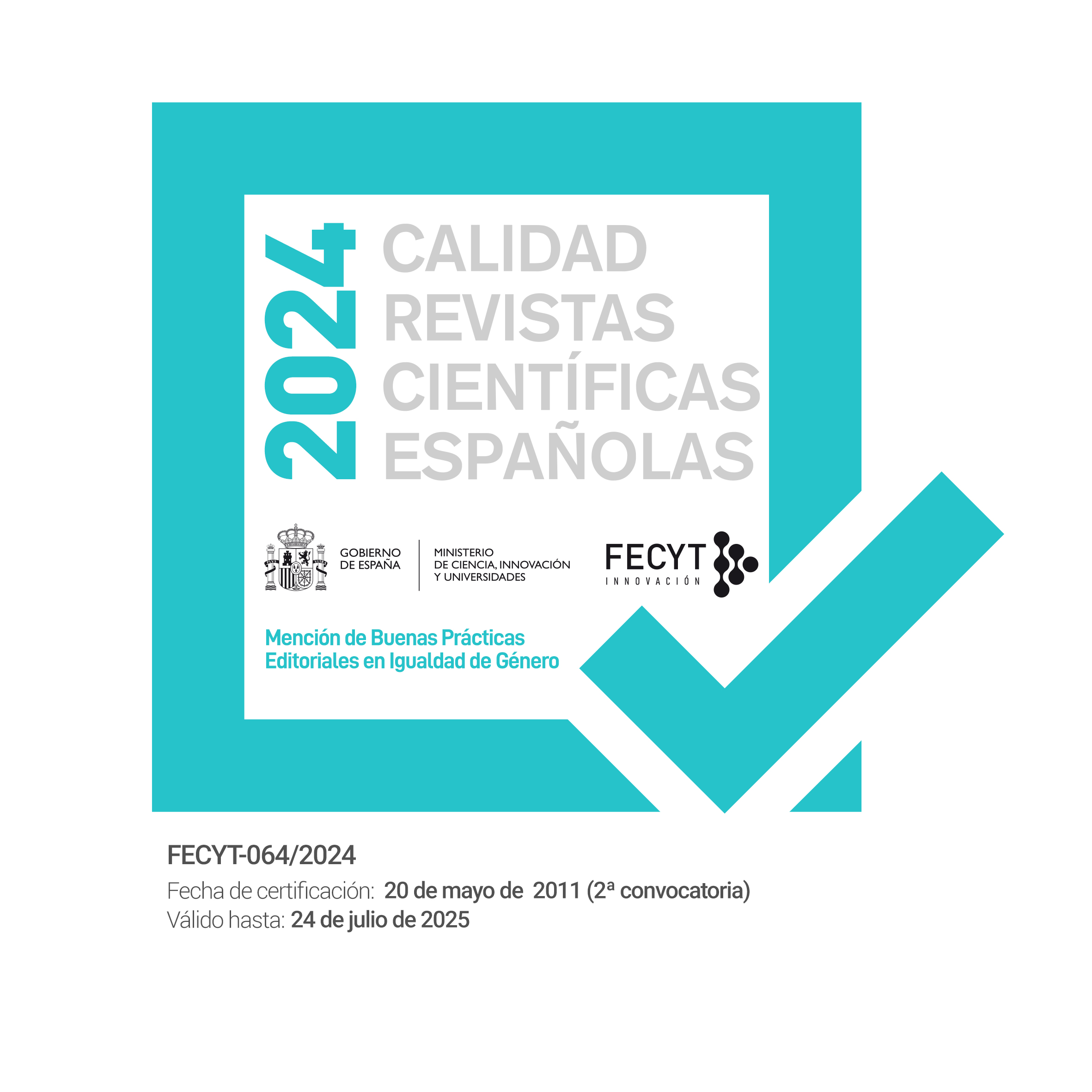Educación en Derechos Humanos: formación ética-cívica de los educadores sociales como medio para prevenir el ciberbullying
DOI:
https://doi.org/10.7179/PSRI_2017.30.13Palabras clave:
derechos humanos, tecnología educativa, métodos, educación en valores, alfabetización tecnológicaResumen
Internet has created a space of exchange of communication and education that has opened the doors for multitude of opportunities in all the facets of the life for any person. Nevertheless, in this work a new form of harassment is analyzed between minors that it is emerging thanks to the possibilities that Internet opens the aggressors: the ciberbullying. The aim is to detect the important aspects on the ciberbullying that they could be an object of an intervention partner educational to propose a plan of ethical - civic formation of the social educators. We analyze the ciberbullying across one systematic review of the literature analyz¬ing the key aspects inside the investigations carried out on this topic: age, level educational and kind, technological tools, motives and reasons, strategies of defense and consequences for the victim and the aggressor.Later we develop a plan of ethical - civic formation for the social educators as relevant agents for the prevention and the elimination of the ciberbullying having in it counts the following types of formation: formation of the autoesteem, empathy and in the individual and social beginning of the human rights, formation in social skills and resolution of conflicts, to educate in not violence, formation in violence of kind, to educate in equality, formation in ethical-virtual literacy and formation in the individual and penal re¬sponsibility. This type of ethical-civic formation of the social educators is necessary in order that they could intervene with children and teenagers for the prevention of the ciberbullying and also for the prevention of the violation of the human rights in different social contexts.
Descargas
Citas
Albert, M. J., & García, M. (2011). La educación en derechos humanos a través del Ciberespacio. Madrid, Ramón Areces.
Albert, M. J. (2011). Derechos Humanos, Educación y Sociedad. Madrid, Ramón Areces.
Albert, M. J. (2014). La vertiente educativa y social de los derechos humanos. Madrid, Centro de Estudios Ramón Areces.
Álvarez, D., Núñez, J.C., Álvarez, L., Dobarro, A., Rodríguez, C., & González Castro, P. (2011). Violencia a través de las tecnologías de la información y la comunicación en estudiantes de secundaria. Anales de Psicología, 27, 221-230.
Aricak, T., Siyahhan, S., Uzunhasanoglu, A., et al. (2008). Cyberbullying among Turkish adolescents.CyberPsychology& Behavior, 11 (3), 253-261.DOI: 10.1089/cpb.2007.0016.
Bonanno, R., & Hymel, S. (2013). Cyber bullying and internalizing difficulties: Above and beyond the impact of traditional forms of bullying. Journal of Youth and Adolescence, 42, 685-698. DOI: 10.1007/s10964-013-9937-1.
Buelga, S., & Pons, J. (2012). Agresiones entre Adolescentes a través del Teléfono Móvil y de Internet. Psychosocial Intervention, 21 (1), 91-101
Buelga, S., Cava, M.J., & Musitu, G. (2010). Ciberbullying: victimización entre adolescentes a través del teléfono móvil y de Internet. Psicothema, 22 (4), 784-789. Retrieved from http://www.psicothema.com/pdf/3802.pdf.
Burguet, M., & Buxarrais, M. R. (2013). La eticidad de las TIC. Las competencias transversales y sus paradojas. Education in the Knowledge Society (EKS), 14 (3), 87-100. Retrieved from http://rca.usal.es/index.php/revistatesi/article/ view/11352.
Calvete E., Orue I., Estévez A., Villardón L., & Padilla P. (2010). Cyberbullying in adolescents: Modalities and aggressors’ profile. Computers in Human Behavior, 26 (5), 1128-1135.
Castro, M., Albert, M. J., Pérez, C., Díaz, G., Gil, R., San Cristóbal, E., Martín, S., Tawfik, M., & Pesquera, A. (2013). Proyectos e Investigación para la mejora de la educación y el uso de la tecnología en la Ingeniería. Revista de la red Estatal de Docencia Universitaria, (REDU), 11, 301-328.
Diamanduros, T., Downs, E., & Jenkins, SJ. (2008).The role of school psychologists in the assessment, prevention, and intervention of cyberbullying. Psychology in the Schools, 45 (8), 693-704. DOI: 10.1002/pits.20335.
Garaigordobil, M. (2011). Prevalencia y consecuencias del cyberbullying: una revisión. International Journal of Psychology and Psychological Therapy, 11 (2), 233-254.
Hinduja, S., & Patchin, J.W. (2010). Bullying, cyberbullying, and suicide. Archives of Suicide Research, 14, 206-221. DOI: 10.1080 / 13811118.2010.494133.
Jose, P., Kljakovic, M., & Scheib, E. (2012). The Joint Development of Traditional Bullying and Victimization with Cyber Bullying and Victimization in Adolescence. Journal of Research on Adolescence, 22, (2), 301-309.DOI: 10.1111 / j.1532-7795.2011.00764.x.
Juvonen, J., & Gross, E. F. (2008). Extending the school grounds? Bullying experiences in cyberspace. Journal of School Health, 78 (9), 496-505. DOI: 10.1111/j.1746-1561.2008.00335.x.
Kowalski, R. M., & Limber, S. P. (2007). Electronic bullying among middle school students. Journal of Adolescent Health, 41 (6), 22-30. DOI: 10.1016/j.jadohealth.2007.08.017.
Li, Q. (2006). Cyberbullying in schools - A research of gender differences. School Psychology International, 27 (2), 157- 170. DOI: 10.1177/0143034306064547.
Martín, A. G., & Tyner, K. (2012). Educación para los medios, alfabetización mediática y competencia digital. Comunicar: Revista científica iberoamericana de comunicación y educación, 38, 31-39.
Mason, K.L. (2008). Cyberbullying: A preliminary assessment for school personnel. Psychology in the Schools, 45 (4), 323-48. DOI: 10.1002 / pits.20301.
Mishna, F., Cook, C., Saini, M., et al. (2011). Interventions to prevent and reduce cyber abuse of youth: A systematic review. Research on Social Work Practice (RSWP), 21, 5-15. DOI: 10.1177 / 1049731509351988.
Mora, J. A. (2008). Ciberbullying: un nuevo reto para la convivencia en nuestras escuelas. Información Psicológica, 94, 60-70.
Oliver, E., & Santos, T. (2014). Socialización preventiva ante el Ciberacoso. Communication & Social Change, 2 (1), 87-106. DOI: 10.4471/csc.2014.09.
Ortega, J. I., & González-Bañales, D. L. (2015). Efectos negativos de las TIC en la escuela de la era digital. Caso: impacto del cyberbullying en el rendimiento académico, una aproximación conceptual. Retrieved from http://reposital. cuaed.unam.mx:8080/jspui/bitstream/123456789/3837/1/VE13.233.pdf.
Parris, L., Varjas, K., Meyers, J., et al. (2012). High school students’ perceptions of coping with cyberbullying. Youth Society, 44, 282-304. DOI: 10.1177 / 0044118X11398881.
Pérez, T. H. (2013). Aproximaciones al estado de la cuestión de la investigación en educación y derechos humanos. Revista Interamericana de Investigación, Educación y Pedagogía, RIIEP, 6 (1). Retrieved from http://revistas.usta. edu.co/index.php/riiep/article/view/1373.
Pessoa, T. et al. (2011). Cyberbullying do diagnóstico de necessidades à construçao de um manual de formação. Pedagogía Social. Revista Interuniversitaria, 18, 57-70.
Schneider, S. K., O’Donnell, L., Stueve, A. et al. (2012). Cyberbullying, School Bullying, and Psychological Distress: A Regional Census of High School Students. American Journal of Public Health, 102 (1), 171-177. DOI: 10.2105/ AJPH.2011.300308.
Sevillano, Mª. L, & Quicios, Mª. P. (2012). Indicadores del uso de competencias informáticas entre estudiantes universitarios. Implicaciones formativas y sociales. Teoría de la Educación. Revista Interuniversitaria, 24 (1), 151-182.
Šléglová, V., & Černá, A. (2011). Cyberbullying in adolescent victims: Perception and coping. Cyberpsychology: Journal of Psychosocial Research on Cyberspace, 5. Retrieved from www.cyberpsychology.eu/view. php?cisloclanku=2011121901&article=4.
Slonje, R. & Smith, & Peter K.(2008). Cyberbullying: Another main type of bullying? Scandinavian Journal of Psychology, 49 (2), 147-154. DOI: 10.1111/j.1467-9450.2007.00611.x.
Smith, P. K., Mahdavi, J., Carvalho, M. etál. (2008). Cyberbullying: its nature and impact in secondary school pupils. Journal of Child Psychology and Psychiatry, 49 (4), 376-385. DOI: 10.1111/j.1469-7610.2007.01846.x.
Sourander, A., Klomek, A. B., Ikonen, M. et al. (2010). Psychosocial Risk Factors Associated With Cyberbullying Among Adolescents A Population-Based Study. Archives of General Psychiatry, 67 (7), 720-728. DOI: 10.1001/ archgenpsychiatry.2010.79.
Starcevic, V., & Aboujaoude, E. (2015). Cyberchondria, cyberbullying, cybersuicide, cybersex: “new” psychopathologies for the 21st century? World Psychiatry, 14 (1), 97-100. DOI:10.1002/wps.20195.
Tey, A., Vilà, R., & Martín, M. (2014). Competencias para el aprendizaje ético en estudiantes universitarios de enfermería y pedagogía. REDU. Revista de Docencia Universitaria, 12 (1), 337-352.
Tokunaga, R. S. (2010). Following you home from school: A critical review and synthesis of research on cyberbullying victimization. Computers in Human Behavior, 26 (3), 277-287. DOI: 10.1016/j.chb.2009.11.014.
Torres, C. Robles, J.M., & De Marco, S. (2013). El ciberacoso como forma de ejercer la violencia de género en la juventud: un riesgo en la sociedad de la información y del conocimiento. Ministerio de Sanidad, Servicios Sociales e Igualdad.
Varjas, K., Talley, J., Meyers, J., Parris, L., & Cutts, H. (2010). High school students’ perceptions of motivations for cyberbullying: an exploratory study. Western Journal of Emergency Medicine, 11 (3), 269-273.
Walrave, M., &Heirman, W. (2011). Cyberbullying: Predicting victimisation and perpetration. Children & Society, 25 (1), 59-72. DOI: 10.1111/j.1099-0860.2009.00260.x.
Wong-Lo, M., & Bullock, L. M. (2011). Digital aggression:Cyberworld meets school bullies. Part of a special issue: Cyber-bullying By: Preventing School Failure, 55 (2), 64-70. DOI: 10.1080/1045988X.2011.539429
Descargas
Publicado
Cómo citar
Número
Sección
Licencia
Derechos de autor 2017 Pedagogía Social. Revista Interuniversitaria

Esta obra está bajo una licencia internacional Creative Commons Atribución-NoComercial-CompartirIgual 4.0.
Derechos de reproducción y archivo
La versión publicada de los artículos podrá ser autoarchivada por sus autores en repositorios institucionales y temáticos de acceso abierto. No obstante la reutilización total o parcial de los mismos en nuevos trabajos o publicaciones deberá ser autorizada por Pedagogía Social. Revista Interuniversitaria.
Los trabajos publicados deberán ser citados incluyendo el título de la Revista, Pedagogía Social. Revista Interuniversitaria, nº, páginas y año de publicación.
Responsabilidades éticas
Pedagogía Social. Revista Interuniversitaria no acepta material publicado anteriormente en otros documentos. Los/as autores/as son responsables de obtener los permisos oportunos para reproducir parcialmente material de otras publicaciones y citar correctamente su procedencia. Estos permisos deben solicitarse tanto al autor/a como a la editorial que ha publicado dicho material.
Es obligación de Pedagogía Social. Revista Interuniversitaria detectar y denunciar prácticas fraudulentas.
En la lista de autores/as firmantes deben figurar únicamente aquellas personas que han contribuido intelectualmente al desarrollo del trabajo.
La revista espera que los/as autores/as declaren cualquier asociación comercial que pueda suponer un conflicto de intereses en conexión con el artículo remitido.
Los autores deben mencionar en el manuscrito, preferentemente en el apartado del método, que los procedimientos utilizados en los muestreos y controles han sido realizados tras la obtención de consentimiento informado.
La revista no utilizará ninguno de los trabajos recibidos con otro fin que no sea el de los objetivos descritos en estas normas.
Aviso de derechos de autor/a
© Pedagogía Social. Revista Interuniversitaria. Los originales publicados en las ediciones impresa y electrónica de esta Revista son propiedad del Pedagogía Social. Revista Interuniversitaria, siendo necesario citar la procedencia en cualquier reproducción parcial o total.
Salvo indicación contraria, todos los contenidos de la edición electrónica se distribuyen bajo una licencia de uso y distribución “Creative Commons Reconocimiento-No Comercial 3.0 España” (CC-by-nc). Puede consultar desde aquí la versión informativa y el texto legal de la licencia. Esta circunstancia ha de hacerse constar expresamente de esta forma cuando sea necesario.






